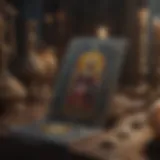Exploring Tarot Decks: A Comprehensive Guide
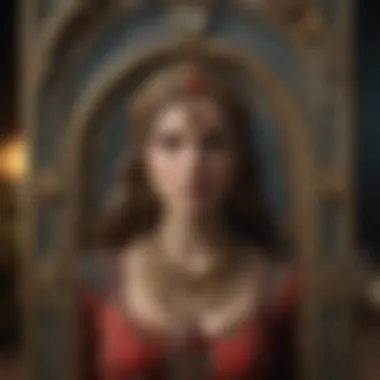

Intro
The intricate relationship between tarot cards and their companion literature is more than just a simple partnership; it acts as a cornerstone for practitioners of varying levels in the metaphysical community. This article will provide an in-depth analysis of how tarot decks interact with their instructional texts, enhancing the tarot reading experience. It will also explore different tarot systems and their applications, whether for personal insight or professional readings. Whether you are a novice seeking guidance or an experienced tarot reader looking to deepen your understanding, this guide aims to enrich your practice.
Understanding the components of tarot is integral to grasping its significance. Each tarot card deck contains a series of symbolic images that resonate with various elements of the human experience. When paired with a companion book, these cards can unlock deeper meanings and insights.
Characteristics of Each Zodiac Sign
While the connection between tarot and astrology can be a complex one, it is essential to note that certain traits of zodiac signs can influence tarot interpretation. Each sign comes with its distinct characteristics that can provide valuable context during a reading.
Overview of Personality Traits
For instance, Aries is recognized for being bold and energetic, while Taurus is seen as reliable and patient. The duality of Gemini’s curious nature contrasts with the emotional depth of Cancer.
Strengths and Weaknesses
Understand that strengths such as Leo’s leadership or Virgo’s analytical mindset may come into play when interpreting tarot readings for individuals under these signs. Conversely, weaknesses may also inform the interpretation; for example, Capricorn's tendency towards rigidity could reflect in certain cards.
Compatibility with Other Signs
Incorporating astrological compatibility into your tarot readings can offer additional layers of insight. For example, a reading may look different if it involves a Gemini-Capricorn relationship compared to a Leo-Libra pairing.
How to Interpret Tarot Cards
Interpreting tarot cards requires both intuition and knowledge of the card meanings. Understanding distinctions between the Major and Minor Arcana is crucial.
Major and Minor Arcana
The Major Arcana cards signify overarching themes and significant life events. In contrast, the Minor Arcana reflects the more everyday aspects of life.
Meaning of Key Cards
For instance, the Fool represents new beginnings, whereas the Death card symbolizes transformation. Knowing these meanings helps in providing readings that are rich and thoughtful.
Sample Interpretations in Different Spreads
When using spreads, the context provided by the structure of the layout can lead to varied interpretations. A three-card spread may offer a different type of clarity than a Celtic Cross.
Overview of Deck Styles
Not all tarot decks are created equal. Some, like the Rider-Waite, are renowned for their rich symbolism, while others may adopt minimalistic styles, such as the Modern Witch Tarot. Each style has its unique way of conveying messages.
Popular Decks and Their Unique Features
Decks such as the Thoth Tarot and Tarot de Marseille come with distinct aesthetics and cultural influences, shaping how they are understood and interpreted. Familiarity with popular decks enhances your tarot skills.
"The fusion of tarot with astrology and other esoteric systems not only enriches your readings but also adds layers of significance that might otherwise be overlooked."
Epilogue
By understanding the synergy between tarot card decks and their companion literature, practitioners can significantly enhance the quality and depth of their readings. Whether one is interpreting zodiac influences or exploring the nuances within individual cards, insights gained can pave the way for more meaningful, personalized experiences in the art of tarot.
As we continue, this guide aims to systematically elaborate on each component of tarot practice, offering practical applications to aid both novices and seasoned readers.
Understanding Tarot: An Preface
Tarot has long been a subject of intrigue and exploration. As we delve into its complexities, this section sets the stage for understanding both the cards and their interpretations. The importance of grasping the fundamentals of tarot lies in its potential to provide personal insights and guide readers through various life experiences.
Tarot serves not only as a divination tool but also as a mirror reflecting one’s inner thoughts and feelings. Engaging with these cards can foster a deeper connection to oneself, encouraging individuals to confront challenges and embrace opportunities for growth. In this way, understanding tarot can be both enlightening and transformative.
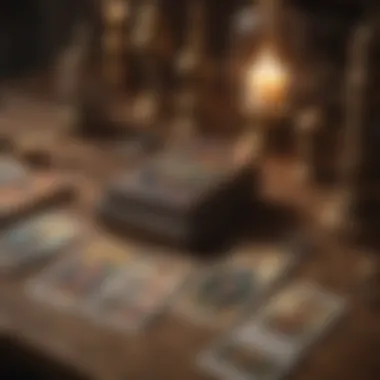

Definition and Purpose of Tarot
Tarot is a deck of cards traditionally used for divination, self-reflection, and exploration of the subconscious. The standard tarot deck consists of 78 cards, divided into the Major Arcana and Minor Arcana. Each card carries unique imagery and meanings that invite interpretation from various angles.
The primary purpose of tarot is to provide insight. It acts as a tool for introspection, often used in readings to answer specific questions or to explore broader themes in one’s life. Many people find that tarot offers clarity in complex situations, helping to illuminate paths that may not have been previously evident. Consequently, its application ranges from day-to-day inquiries to profound spiritual journeys.
Historical Background of Tarot
The origins of tarot are steeped in mystery, tracing back to the 15th century in Europe. Initially, tarot cards were created for playing games, notably in Italy, where they were known as tarocchi. The transition from a mere card game to a spiritual and divinatory tool took place over the centuries, influenced by various mystic traditions and cultural shifts.
By the 18th century, tarot began to be interpreted as a form of esoteric wisdom. The symbolic art present in the decks drew interest from philosophers and occultists. Notably, groups such as the Hermetic Order of the Golden Dawn contributed significantly to the revival of interest in tarot as a mystical practice.
Today, tarot is valued not only for its artistic expression but also for its psychological and spiritual insights. This complex history underscores the evolving nature of tarot and highlights how it can serve a multitude of purposes, making its study a fascinating endeavor for both practitioners and curious minds alike.
Components of a Tarot Deck
The components of a tarot deck hold vital significance for every practitioner. Understanding these elements enhances the depth of readings and the overall experience of working with tarot. Each card within a deck tells a story and conveys profound messages that can resonate with both the reader and the querent. Grasping the various components is essential to harnessing the power of tarot effectively.
Major Arcana: The Key Cards
The Major Arcana consists of 22 cards that represent significant life events and spiritual lessons. These cards are pivotal in any tarot reading, often holding the most weight in interpretations. Each Major Arcana card encapsulates archetypes and universal themes, such as The Fool or The World, that invite deep reflection. Practitioners find that these cards often signify turning points or key influences in a querent's life, thus warranting a greater focus during readings.
Key Points About the Major Arcana:
- Significance: Major Arcana cards often denote lessons of a spiritual nature instead of everyday situations.
- Symbolism: Each card carries rich symbolism that can give insights into personal journeys.
- Interpretation: The context of the spread can change the interpretation of these cards significantly.
Minor Arcana: The Suits Explained
The Minor Arcana is made up of 56 cards divided into four suits: Cups, Pentacles, Swords, and Wands. Each suit reflects different aspects of daily life, emotions, material concerns, and actions. This division allows for nuanced readings where practitioners can delve into specific areas in a querent's life.
- Cups represent emotions, relationships, and intuitions.
- Pentacles relate to material aspects, work, and finances.
- Swords focus on thoughts, challenges, and conflict.
- Wands depict creativity, action, and willpower.
Understanding the suits equips readers to interpret the cards more accurately, as they can identify which aspects of life are being highlighted in a reading.
Court Cards: The Personalities
Court Cards, which include the Page, Knight, Queen, and King of each suit, serve as representations of personalities and roles within a reading. These cards can signify actual individuals in a querent's life or embody traits and characteristics. Recognizing the unique influence of each court card can guide practitioners to tailor their interpretations.
- Pages symbolize curiosity, youth, and new beginnings.
- Knights indicate action and pursuit of goals.
- Queens embody nurturing and supportive qualities.
- Kings reflect authority, leadership, and mastery.
Being adept with the Court Cards allows for a personal touch in readings, providing clarity about the relationships and dynamics at play in the querent's situation.
Understanding the components of a tarot deck, from the Major and Minor Arcana to the Court Cards, is fundamental for a comprehensive reading. Each card reflects distinct messages that enrich the practitioner’s insights, ensuring an informed approach to the art of tarot.
The Role of the Companion Book
The companion book serves a critical function in the realm of tarot. It bridges the gap between the tarot cards and the reader's understanding. Readers at different levels can understand what a card signifies in various contexts. Without this guidance, practitioners may miss subtle meanings that enhance their readings.
How Books Enhance Tarot Understanding
Books offer the foundation for a deeper grasp of tarot. Each card holds distinct meanings, rooted not only in general interpretations but also in the personal experience of the reader. Companion literature provides insights into the symbolism of each card, its reversed position, and how it relates to others in a spread. This information is essential for conducting comprehensive readings.
Additionally, books often include historical context. Understanding where the tarot comes from can greatly influence how one interprets the readings. The amalgamation of meanings between the cards and their symbolism is often intricate. Thus, having a source to refer to is invaluable.
In a practical sense, many books feature exercises that allow readers to practice their interpretations. This active engagement solidifies knowledge and builds intuition.
Common Features of Tarot Companion Books
Most tarot companion books share several common features:
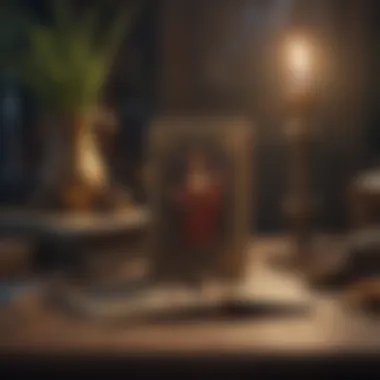

- Card Descriptions: Detailed interpretations of each card.
- Historical Context: Background information about tarot's evolution.
- Spreads: Examples of various tarot spreads for different purposes.
- Exercises: Practice techniques to refine interpretation skills.
- Case Studies: Real-world examples illustrating readings.
Some books go further, presenting different schools of thought regarding the cards. They may address diverse tarot systems such as the Thoth Tarot or Rider-Waite. This comparison aids practitioners in understanding various approaches and possibly finding one that resonates with them.
Comparing Different Tarot Publications
There are numerous tarot publications, each offering unique insights. Some well-regarded titles include The Ultimate Guide to Tarot Card Meanings by Liz Dean and Tarot Fundamentals by Rachael Pollack.
When comparing these publications, readers should consider:
- Target Audience: Is the book aimed at beginners or advanced practitioners?
- Depth of Content: Does it focus simply on meanings or elaborate on complex interpretations?
- Writing Style: Is it conversational or academic? A comfortable style can facilitate learning.
- Inclusion of Visuals: Many books benefit from illustrations and diagrams; they enhance comprehension of card layouts and meanings.
Ultimately, selecting a companion book that complements individual learning styles and interests can dramatically impact the tarot reading experience.
"A well-chosen companion book can transform your understanding of tarot from surface knowledge to a profound connection with the cards."
Choosing the Right Tarot Deck and Book
Selecting a compatible tarot deck and an appropriate companion book is crucial. It can significantly influence the depth and accuracy of readings. Each deck has its unique aesthetics, symbolism, and thematic focus, which might resonate differently with different users. The reading experience becomes more enriching when the tarot deck aligns with the reader's intuition and knowledge.
A deck's imagery often serves as a springboard for insights. It is essential to ensure that the chosen deck communicates the narratives that reflect the reader's perspective. Moreover, the companion book should not only explain card meanings, but also offer guidance on interpreting those meanings within various contexts. Finding a fitting combination elevates the tarot reading experience.
Factors to Consider When Selecting a Deck
When searching for the right tarot deck, several factors come into play:
- Artistic Style: Each deck features varying artistic expressions, such as watercolors, traditional illustrations, or modern graphics. Choose a style that speaks to you.
- Thematic Focus: Decks can center around different themes, including mythology, nature, or historical events. Consider what theme resonates most.
- Card Quality: Look for decks printed on durable, quality cardstock. This is especially important if you plan to handle the cards frequently.
- Guidance Availability: Assess whether the deck comes with helpful materials or guides. Some decks include detailed companion books that aid in understanding.
Assessing Compatibility with Books
Compatibility between the deck and its companion book determines how effectively you can interpret the cards. Important aspects to consider include:
- Content Depth: Evaluate if the book covers advanced meanings, spreads, and practical applications, beyond simple card definitions.
- Tone and Style of Writing: The writing style should align with your understanding and way of thinking. Some books may be very scholarly, while others are more informal, which might be more digestible for some.
- Cohesion with Deck: Check if the book references the deck’s specific symbolism and artwork. A direct association enhances comprehension.
- Practice Suggestions: Books should provide exercises or sample spreads to practice and reinforce learning.
Choosing the correct tarot deck and companion book forms a substantial foundation for building your tarot practice. This careful selection process fosters ease in learning and enriches the path toward mastery.
Practical Application of Tarot Readings
The practical application of tarot readings serves as a crucial element in understanding the full scope of tarot as a tool for insight and self-exploration. Engaging with tarot can lead individuals to profound realizations, both personally and professionally. Each reading provides a snapshot of insights into the querent’s situation, revealing underlying emotions, challenges, and pathways forward.
Different Spreads and Their Interpretations
Various spreads serve as frameworks for tarot readings, directly influencing their interpretations. A spread refers to the layout of cards chosen for a reading, where each card's position holds specific significance. Common spreads include the single-card draw, three-card spread, and the Celtic Cross, each offering unique insights.
The single-card draw is often a tool for daily guidance. It allows for quick reflection and sets the tone for one’s day. The three-card spread typically explores the past, present, and future, providing a more layered understanding of a situation. The Celtic Cross is more complex, offering a comprehensive view of challenges and opportunities through several cards each with its meaning.
Understanding how to interpret the cards based on their position within a spread enhances the reader’s ability to convey meaningful insights to the querent. For example, in a three-card spread:
- Past Position: This card reveals influences from the past affecting the current situation.
- Present Position: Represents the current state or challenge that needs attention.
- Future Position: Indicates potential outcomes or what lies ahead if current paths are followed.
Integrating Book Guidance into Readings
Books accompanying tarot decks should not just be seen as optional references; their guidance is integral to effective readings. These companion texts provide interpretations, card meanings, historical contexts, and tips for insightful readings.
When integrating book guidance into readings, it's important to strike a balance between intuition and learned knowledge. A seasoned tarot reader may rely on their instincts but will benefit from the clarity that a well-written book offers. For instance, when pulling a card that depicts a challenging situation, consulting the companion book might highlight nuanced meanings or associated emotions that enrich the reading experience.
"Tarot readings are not solely about the future; they often reflect our inner dynamics and cognitive patterns, leading us to self-discovery."
Using the companion book can elevate interpretations and support query responses. It is beneficial to have the companion book accessible during a reading session. This allows for on-the-spot clarifications or deeper dives into specific card meanings as questions arise. Therefore, the synergy between intuition and book knowledge creates a more robust reading experience for both the reader and querent.
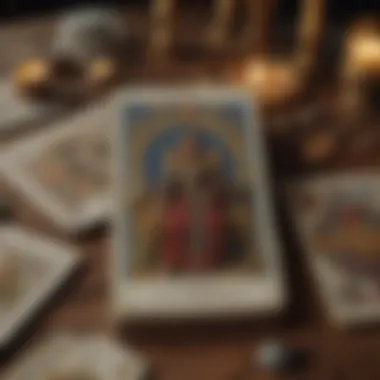

Advanced Tarot Techniques
In the vast field of tarot, advanced techniques can enhance both readings and personal growth. As practitioners develop their skills, they often seek methods to refine interpretations and deepen their intuitive connections. This section will cover two distinct but complementary approaches: Intuitive Reading versus Structured Approaches and Developing Your Unique Reading Style.
Intuitive Reading versus Structured Approaches
Intuitive reading involves tapping into personal insights and feelings during a tarot reading. It allows for a spontaneous connection between the reader and the cards. This method can lead to unique interpretations, as it emphasizes personal resonance over traditional meanings. Many practitioners find this approach liberating and revealing. It can produce richer readings that reflect soul-level insights.
On the other hand, structured approaches rely on established meanings and layouts. Techniques such as the Celtic Cross spread or Lady Harris method follow a specific format to guide readings. This can be beneficial, particularly for beginners or when practitioners feel uncertain. Having a structure often ensures clarity and consistency in interpretation, leading to reliable outcomes.
Both methods have their strengths. Combining intuition with structure may create a comprehensive approach. Readers can start with a structured method to ground their practice and then shift into intuitive insights as confidence grows. The balance between these techniques can enhance the overall reading experience.
Key Benefits of Both Approaches
- Intuitive Reading: More personal and free-form, taps into subconscious thoughts.
- Structured Approaches: Clear guidelines provide consistency, aiding learning.
Developing Your Unique Reading Style
Creating a unique reading style is a significant milestone for any tarot practitioner. Each reader brings their experiences, beliefs, and wisdom into their work. Thus, personal style becomes a blend of knowledge and intuition, shaped by individual philosophy.
To develop this style, consider reflecting on the following:
- Personal Influence: What experiences inform your readings? Consider how your life, beliefs, and cultural background shape what you see in the cards.
- Favorite Deck: The tarot deck you resonate with can influence your style. Each deck brings its energy and symbolism, which may impact how you interpret the cards.
- Practice and Feedback: Experience is also a teacher. Conduct readings for friends or family, and solicit feedback. Surprising insights can emerge from others' perspectives on your interpretations.
As readers evolve, it is essential to remain open to change. Allow new insights, methods, or decks to influence your style. Advancing in tarot is not just mastering techniques but also an ongoing journey of self-discovery.
"The tarot is not a tool for divination; it is an exploration of the mind and a journey into consciousness."
The Spiritual Aspects of Tarot
The spiritual aspects of tarot are not only profound but also essential for practitioners seeking to deepen their understanding and connection to the cards. Tarot serves as a bridge between the tangible and the ethereal, allowing individuals to explore their inner realities and the broader universe. This section will discuss how tarot relates to personal spiritual practices and the role of intuition within the tarot reading process.
Aligning Tarot with Personal Spiritual Practices
Integrating tarot with personal spiritual practices can create a unique space for reflection and growth. Many individuals who engage with tarot find that it enhances their existing spiritual routines. This can involve daily readings, using tarot as a meditation tool, or even integrating card spreads into rituals.
- Daily Draws: Some practitioners draw a card each day as a means to set intentions or gain insights.
- Meditation: Meditating on specific cards can reveal deeper meanings and promote mindfulness.
- Rituals: Using tarot during ceremonies or personal rituals can help align intentions with spiritual goals.
The benefits of this alignment include enhanced intuition, increased self-awareness, and a greater sense of connectedness to one’s spiritual path. Engaging with tarot in these ways allows users to explore their soul’s desires and fears, providing clarity on personal and existential dilemmas.
Exploring the Intuitive Side of Tarot
Intuition plays a critical role in tarot reading, acting as the guiding force behind interpretation. While knowledge of card meanings is important, the ability to tap into one’s intuition can lead to richer and more meaningful readings. This intuitive aspect often goes beyond rational thought, engaging with the unconscious mind.
Various techniques can enhance intuitive abilities:
- Journaling: Maintaining a tarot journal can help track intuitive insights and develop a personal lexicon of meanings.
- Practice: Regular readings improve both familiarity with the cards and intuition.
- Trusting instincts: It’s vital to trust one’s gut feelings when interpreting cards, as this aligns with the deeper spiritual message.
Intuition is the whisper of the soul, guiding us through the complexities of the tarot.
Closure: Embracing the Tarot Journey
Embracing the journey of tarot exploration involves an acknowledgment of its vastness and complexity. After learning about the tarot's components and how companion books enrich understanding, readers can approach their practice with renewed perspective. It is crucial to reflect on how each card and its accompanying literature contributes to a unique experience that is personal and evolving.
The engagement with tarot fosters self-discovery and insight. Practitioners can find value in the moments of clarity that arise during readings. Over time, this reflection on personal growth can lead to a deeper understanding of not only the cards but the self as well. In addition, exploring different styles and techniques can vary the tarot experience and keep it stimulating.
Reflecting on the Learning Experience
Throughout the process of learning tarot, reflection serves as a powerful tool. Practitioners should make it a habit to contemplate the meanings that they have encountered and how those meanings resonate with their individual experiences. This might entail journaling about readings, responding to personal observations, or even discussing interpretations with fellow practitioners.
Painstaking reflection aids in developing an intricate understanding of the tarot's symbols and myths. It can be beneficial to revisit earlier insights as the journey progresses. The act of reflection bridges the gap between theoretical knowledge and practical application, ensuring that learning is not merely an academic exercise but a lived experience.
Future Directions in Tarot Exploration
As tarot continues to evolve, future directions in exploration promise to present exciting possibilities. New interpretations, decks, and methodologies are increasingly coming to light. By staying informed about current trends and practices, one can ensure that their tarot journey remains relevant.
Many are now integrating diverse cultural perspectives and modern themes into their practice. Therefore, exploring genres outside traditional tarot literature can yield surprising benefits. Engaging with online communities on platforms such as Reddit can also be advantageous for practitioners looking for fresh insights.
